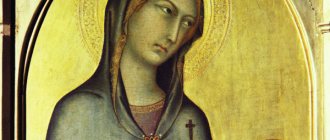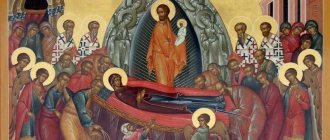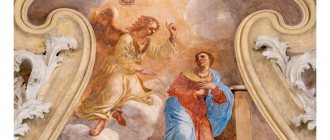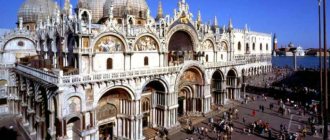Every spring, the Orthodox Church celebrates a number of huge holidays that are of particular significance for believers. The first spring holiday is St. Eudoxia's Day, which according to the new calendar falls on March 14, and previously it was celebrated on March 1.
I heard the story of this girl given to us as a child from my grandmother, who was a deeply religious person. She constantly observed the traditions of this day and believed in its signs. In addition, she told why this holiday is important for ladies, and what they absolutely need to do. I will tell you about this secret and features of the celebration of March 14 among the people in this article.
The story of the holy sufferer
According to church traditions, Evdokia lived in Iliopol, and was among the richest people, but she did not stand out for her fortune. The woman was endowed with extraordinary beauty, from which all boys and men lost their heads. In her youth, she was a harlot and led a far from righteous life, but she was still able to settle down when she met Herman, a minister of a Christian monastery. Thanks to him, the woman realized that she was living incorrectly and decided to dedicate her life to serving God.
After repentance, Evdokia went to a nunnery, where she lived until her death. Within the walls of the sacred temple, she never stumbled and strayed from the right path, for which she was appointed a mentor for the other nuns. In addition, the woman saw prophetic dreams, and the prayers uttered from her lips acquired incredible power. The Monk Eudokia was adored and revered both in the monastery and outside it, but she also had enemies, including the ruler Vincent, who hated Christianity. It was on his orders that a nun at the age of 56 was killed.
Folk names and traditions of the day
March 14 is an important day in folklore. According to the old style, it fell on the 1st and symbolized the onset of spring. Until the 15th century, on this day the Slavs celebrated the New Year, tightly tied to the agricultural calendar. In Orthodoxy, March 14 is patronized by the Venerable Martyr Evdokia, a righteous woman revered by the people.
Most often, signs call this day Avdotya Plyushchikha. Usually in March, warm weather sets in, the snowdrifts begin to melt and lie on the ground no longer as a continuous blanket, but as separate islands - “buns”. The second name for March 14 in the signs is Evdokia Svistunya, and it is explained by the strong and gusty, whistling March winds. In addition, in the old days, adults and children specially went outside and blew whistles to promote the onset of spring.
Avdotya, or Evdokia, is a revered martyr in Christianity.
Important! In folk tradition there are also the names Avdotya-vesnovka and Avdotya-soak the hem. The first is associated with the onset of spring, and the second with the March thaws and abundant melting of snow.
Who is Evdokia Svistunya (Avdotya Plyushchikha)
According to legend, Eudokia Iliopolis lived in the Phoenician city of Heliopolis in the 1st century and was a rare beauty. She led a dissolute lifestyle, which earned her a huge fortune, but later she converted to Christianity. She gave all her money to the needs of the church, and she became a nun and eventually became an abbess.
The legend says that one day local authorities learned about treasures supposedly hidden in the monastery and wanted to take them away. Evdokia did not let them into the holy monastery, but went out to meet the soldiers. They hung her on a tree and began to scourge her. God's punishment overtook the offenders on the same day, and Evdokia gained great fame and continued to live in the monastery until her martyrdom around 170. Throughout her life, the venerable martyr helped strangers and healed the sick, which is why believers still honor her memory on March 14th.
Folk tales
Among the people, the Day of St. Eudokia, or, as she is also called, Yavdokha, marks the arrival of spring. According to the old calendar it was celebrated on March 1, and according to the new calendar it was celebrated on March 14. People believed that the great martyr received from the Lord special keys to spring, and had the right to decide for herself when warming would come and nature would awaken from hibernation.
It is believed that specifically on the Day of St. Eudoxia on March 14, spring gains full rights. It is not permissible for us to begin field work before this date, because... this may anger the great martyr, and instead of warm, sunny days there will be frost. People believed that the upcoming weather would depend in almost everything on how the Yavdohi holiday went. They directed attention to the behavior of the tiles, the presence of wind and sun. In addition, there are a number of traditions, the observance of which gave the population rich harvests, well-being in the home and happiness in the family.
Evdokia March 13 – folk sayings
Many folk holidays are associated with various sayings, which contain the wisdom of more than one generation. In most cases, they are similar to the signs for Evdokia on March 14:
- Hired from Evdokia on Peter's Day.
- If Yavdokha wags her tail, winter will wander the fields for a long time.
- Just like on Yavdokha, the sky is fine - the summer will be nice, if it rains - the summer will be warm and wet, if there is snow - for a harvest and good honey collection.
- The Evdokeys came and gave the peasant some idea: to sharpen the plow, to repair the harrow.
- Avdotya the freckle springs spring. Evdokia - soak the hem, it’s wet under the threshold.
- Evdokia is red, and spring is red. The first thaw with Evdokia Ivy.
Long-standing traditions
Saint Eudoxia was greeted on March 14 with a cheerful and festive celebration. On this day they held festivities, performed various rituals, prayed for their health, and began agricultural work. Almost all traditions are observed in villages to this day, and here are some of them:
- To ensure prosperity reigned in the house, housewives began baking cookies in the shape of larks from the very morning. Young girls and children walked around the courtyards with this delicacy, sang inviting spring songs and glorified the beginning of spring.
- For the well-being of the family, it was necessary to throw a handful of earth towards the flying swallows, who at that time were returning from warmer climes. With all this, the words were uttered: “For you, swallow, for the nest.” And so that the family would not be in poverty, this bird certainly had to be fed with bread.
- In order to be healed from ailments, on the feast of St. Eudoxia it was customary to wash with melt water, which was obtained from snow collected the day before. During the ritual, people prayed to the great martyr and asked for good health.
- The ladies believed that they could speed up the arrival of spring and the arrival of warm days by lighting the fire with branches that were collected in the forest early in the morning on Yavdokha Day.
- Also on this holiday, ladies got rid of negativity and asked the holy great martyr for happiness. To do this, even before sunrise, they took a mirror and expressed into it everything bad that had accumulated in their soul, sobbed and complained about their fate, after which, they wrapped it in dark cloth, broke it and buried it far from home.
- For a secure harvest, on this day the grains of wheat, which were planted first, were blessed in the church. Seedlings were also sown in pots, because it was believed that frost would not damage them.
- Gardeners cut dry branches of fruit trees so that they would bear fruit well this year and would not be overcome by diseases or pests.
Yavdokha’s biggest sin was damaging the swallow’s nest. People believed that whoever dared to harm these birds on this special day would suffer misfortune.
Rituals for Evdokia on March 14
There are many traditions and rituals associated with this holiday, for example, if a person sees a swallow, then he must throw a handful of earth at it, while saying: “On you, swallow, on the nest!” Evdokia Day in March is associated with the following traditions:
- During the day, the men threw off the snow, and brought branches from the forest and heated the stove so that the spring would be warm.
- In the evening you need to put a damp rag under the threshold and if it is frozen in the morning, it means that spring will be cold.
- From this day on, women began to weave, doing it until the onset of sowing. The finished canvases were bleached in March water, and they received special qualities.
- March 14 is considered the day of alms and it is recommended to give not only for yourself, but also for the deceased. Thanks to good deeds, the sins of the deceased are forgiven. Try to do good deeds modestly so that no one sees.
Folk signs
People believed in the signs of St. Eudoxia's Day, by which they determined what the spring and summer weather, productivity and health of livestock would be like. Some of them have survived to this day:
Almost all signs to this day help farmers choose the right day to start agricultural work and grow rich harvests.
Source: tayniymir.com
Share:
EVDOKIA
[Greek Εὐδοκία] († ca. 160-170), prmts. (mem. March 1). A Samaritan by origin and faith, E. lived in Heliopolis in Phenicia (now Baalbek, Lebanon). During the reign of the Emperor. Trajan (98-117) she, being a harlot, collected enormous wealth thanks to her extraordinary beauty. E. was converted to Christianity by Mon. Herman, her decision to be baptized was strengthened by the appearance of Arch. Michael, who snatched her from the hands of Satan. E. gave her fortune to the Bishop of Heliopolis. Theodota for the needs of the poor and took monastic vows as a wife. monastery near the monastery where Herman labored. After the death of the abbot. Kharitina, for her strict ascetic life, was chosen as her successor. One of the former E.'s admirers, named Philostratus, who came to the monastery and tried to convince her to return to her former life, fell dead when the saint blew in his face. Through the prayer of E. Philostratus was resurrected, repented and believed in Christ.
Prmts. Evdokia. Icon. XIX century (MZK) Prmts. Evdokia. Icon. XIX century (MZK)
The local ruler Aurelian was informed that E. was storing countless treasures in the monastery, and he sent a comite with a detachment of 300 soldiers to destroy the monastery. The warriors surrounded the monastery and wanted to attack at night, but, held by divine power, for a long time they could not take a single step closer to the mon-ryu. On the 3rd day, they were attacked by a huge snake; the Komit and 3 warriors from the detachment survived. Then Aurelian sent his son to take the monastery, but on the way he fell from his horse and died. Grieving for his son, Aurelian, on the advice of Philostratus, sent the tribune Babylon to E. with a request to bring him back to life. Through prayer, the holy young man was resurrected. Aurelian and his entire family were baptized, his son later. became the bishop of Heliopolis, and his daughter Gelasia took monastic vows in the monastery where E. Rome asceticised. the governor Diogenes, who wanted to marry Gelasia, after the death of Aurelian, sent 50 soldiers, ordering to seize E. In E.’s vision it was revealed that she must show perseverance, professing faith in Christ. She voluntarily followed the soldiers, hiding particles of the Holy Gifts on her chest under her clothes. When, by order of Diogenes, the saint was hanged on a tree and stripped to the waist to be scourged, particles of the Holy Gifts fell to the ground. The servants who tried to raise the particles were scorched by fire, and the flames that descended from the sky incinerated the governor. E. resurrected him and his servants, as well as the recently deceased wife of the Comite Diodorus, who had been burned in a bathhouse. After the miracles performed by the saint, Diogenes, Diodorus with his wife Firmina and many people believed in Christ. Among other miracles of E., the Life mentions the resurrection of the youth Zinon, who was bitten by a serpent, and the killing of the serpent.
E. continued her monastic life in the monastery, coming from time to time to the city to confirm newly converted Christians in the faith. She was beheaded by Diogenes' successor, the pagan Vincent, having lived 56 years after her baptism. Thus, her death can be approximately attributed to 160-170.
Greek the lengthy Life of E. is, according to researchers, a translation from the Sir. language. Bollandists consider him legendary because of the abundance of miracles and a number of anachronisms (at the beginning of the 2nd century Mont-Rey did not yet exist, and the episcopal see in Heliopolis was established by Equal to the Apostles Constantine the Great) and attribute the time of E.’s life to the 5th century. It is also assumed that in the legend that has reached us, information about E. and the Persians who lived in the first centuries of Christianity merged. mts. Evdokia (memorial August 4, September 11). According to the archbishop. Sergius (Spassky), in the Life of E. we could not be talking about monks in modern times. understanding, but about the societies of virgins and virgins known from ancient times; the department in Heliopolis could have been destroyed during the era of persecution, and then restored by Constantine the Great.
An abbreviated Life (BHG, N 605b) and a Life as part of the Imperial Minology of 1034-1041 have also been preserved. (the so-called Tsar’s Menaion, or Latyshev’s Menaion). E.'s life was translated into cargo. language.
Source: BHG, N 604-605e; ActaSS. Mart. T. 1. P. 875-887; PG. 117. Col. 332-333 [Minology of Vasily II]; SynCP. Col. 498-499; Latyshev V.V. From hagiogr. Literatures: 1. Abridged Life of MC. Evdokia; 2. Options for the life of St. Mercury Metafrastovskaya edition from the RKP. RAS // IAN. 1918. T. 12. Ser. 6. P. 1583-1585; JSV. March. pp. 5-39.
Lit.: Sergius (Spassky). Monthsword. T. 2. P. 59; T. 3. P. 90; ΘΗΕ. Τ. 5. Σ. 1020; Janin R. Eudocie (2) // DHGE. T. 15. Col. 1336; Lucchesi G. Eudocia // BiblSS. Vol. 5. P. 145-147; Σωφρόνιος (Εὐστρατιάδης).῾Αγιολόγιον. Σ. 141-142.
E.P.A.
Hymnography
The memory of E. is noted in the Typikon of the Great Church. IX-XI centuries (Mateos. Typicon. P. 242) without liturgical follow-up. The Studian-Alexievsky Typikon of 1034, which is the oldest surviving edition of the Studite Charter, does not contain E.’s memory. In the Evergetid Typikon, 2nd half. XI century (Dmitrievsky. Description. T. 1. P. 423), relating to the Asia Minor edition of the Studio Charter, under March 1, the canon of the plagal 4th (i.e. 8th) voice, sedala and the cycle of stichera E. Messinian Typikon 1131 are mentioned g. (Arranz. Typicon. P. 125) athono-ital. The edition of the Studio Charter prescribes that on the day of E.’s memory a service should be performed with “Alleluia.”
The instructions of the Jerusalem Typicons of various editions for March 1 are brief and include only the memory of E. or the memory and the instruction to sing “Alleluia”. In the first printed Greek. Typikon (Venice, 1545) there is a reference to the general troparion to the reverend wife in the name of E.: ᾿Εν σο μῆτερ ἀκριβῶς̇ (), which is sung outside of Great Lent; During the period of fasting, it is prescribed to sing “Alleluia” at matins. In early printed Russian The typikon contains a detailed description of the service, indicating the singing of a special troparion E. ( ) on those days when March 1 occurs outside of Pentecost. In the 1682 edition of the Typikon, corrected by Moscow reference workers, the singing of a troparion is also prescribed for the time outside of Lent, but this is not a special troparion, but a general one - the same as in the Greek. Typicone ( ). The next edition (M., 1695) contains the tradition. glory troparion: .
Following E., according to modern. liturgical books, includes the troparion of dismissal of the 4th tone (in the Greek Menaia - the general troparion to the martyr: ῾Η ἀμνάς σου ᾿Ιησοῦ̇ (); in the Slavic Menaia - the troparion of the 8th tone); kontakion (only in Slavic) 4th voice (indications of the Russian old printed Typicons regarding the voice of the E. kontakion differ: 1st and 2nd voices) with ikos; canon (in the Slavic Menaia - anonymous canon of the 2nd tone, without an acrostic, the Greek original is known from manuscripts (see: AHG. T. 7. P. 1-14), irmos: Δεῦτε λαοί̇ ( ), beginning: Τὴν τῆς ψυχῆς νῦν ἀγαθῦναί μου κάκωσιν ( ); in Greek Menaion - anonymous canon of the plagal 4th (i.e. 8th) voice, acrostic: Τῆ ς Εὐδοκίας τοὺς ἀγῶνας αἰνέσω (I will praise Evdokia’s suffering), irmos: ῎Αισωμεν τῷ Κυρίῳ̇ (), beginning: Τὴν ἐξ ἀπροσεξίας (Hedgehog from inattention); the last canon is also known in the famous translation, for example in the handwritten glory. Menea of the State Historical Museum. Syn. No. 172, late XIV - early XV centuries (see .: Gorsky, Nevostruev. Description. T. 3. Part 2. P. 89), and, apparently, it is this canon that is implied in the instructions of the Evergetid Typikon); sedalny; cycle of 3 stichera-like. In Greek The Menaiah is also placed in a samoglasn for singing “Lord, I have cried” if March 1st happens on Saturday or outside of Pentecost.
Other hymns of E., which were not included in modern times, were also preserved in the manuscripts. editions of liturgical books: kontakion of the 3rd tone on similar to ῾Η παρθένος σήμερον̇ ( ), beginning: Μαρτυρίου σήμερον (Torment this day), with ikos (AHG. T. 7. P. 9 ); sedalny.
A. A. Lukashevich
Iconography
E., usually depicted in monastic robes (in a mantle, in a chiton, in a schema, with a doll on her head), is similar in appearance to Evdokia, MC. Persian. A clearly distinguishable image of E. is consistently found in the mineaic cycles around March 1. There are 2 types of images: in agony and a straight-up image full-length or chest-length. In torment, E. is represented in miniatures in the Minology of the beginning. XI century (GIM. Greek 183. Fol. 59), in Minology for a year with cycles of the twelve holidays and in the Life of the Great Martyr. Demetrius (Oxon. Bodl. F. 1. Fol. 30r, 1327-1340), in the wall minology in c. Dormition of the Most Holy Our Lady of Treskavets Monastery, Macedonia (between 1334 and 1343). Single (full-length, chest-length or waist-length), with a cross in the right hand or with a scroll in the left, the other hand, respectively, in prayer - on miniatures in the Minology for March-Aug. from the Patriarchal Library in Jerusalem (Hieros. Patr. 208. Fol. 1r, 12th century); in Greco-cargo. manuscripts of the 15th century. (the so-called Athos Book of Specimens - RNL. QI58. L. 102) - full-length, with a scroll in the left hand; in wall minologies in the center. Vmch. George in Staro Nagorichino, Macedonia (1317-1318), - waist-deep and c. Dormition of the Most Holy Our Lady of the Monastery of Gracanica, Kosovo and Metohija (c. 1320), - chest-length; in icon painting - on the minia for a year (the so-called Sinai hexaptych, 2nd half of the 11th - 1st half of the 12th century, K-pol, monastery of the Great Martyr Church of Catherine on Sinai) - in height.
In the painting of churches, the image of E. was preserved in the c. Holy Cross (Charykly-kilise) in Goreme, Cappadocia (2nd half of the 12th century), and in the altar area of the c. Savior on Nereditsa in Vel. Novgorod (1199), to the north. southeast edge pillar (5th register), chest-length image in a medallion, a cross in the right hand, the left in prayer.
Prmts. Evdokia. Fragment of a miniature from Greco-cargo. manuscripts. XV century (RNB. QI58. L. 102) Prmts. Evdokia. Fragment of a miniature from Greco-cargo. manuscripts. XV century (RNB. QI58. L. 102)
One of the earliest images of the saint in Russian. art - the image on the left margin of the icon “St. Nicholas, with the saints in the fields” (late 12th - early 13th centuries, Novgorod, Tretyakov Gallery). E. (named “Ovdokia”) is depicted upright, wearing a dark brown robe over a lilac-pink chiton, a doll on her head and a blue schema. In her right hand the saint holds a cross, her left hand in front of her chest is open in prayer with her palm facing outward. Paired with E. in the lower right field there is an MC. Blast furnace (?). E. among the selected saints can be seen on the upper field of the icon “The Nativity of Christ, with selected saints” (beginning of the 15th century, Novgorod, Tretyakov Gallery); on the right wing of a 3-leaf folding with the central Yaroslavl icon of the Mother of God from c. prophet Elijah in Sandyry near Kolomna (1491, Moscow, Tretyakov Gallery); on the margins of the Shuya Icon of the Mother of God from the collection of P. I. Shchukin (2nd half of the 16th century, Pskov, Tretyakov Gallery); on the lower field of the Feodorovskaya Icon of the Mother of God (c. 1630, Tretyakov Gallery) she is depicted together with the Great Martyrs Paraskeva and Varvara as the heavenly patroness of the 2nd wife of Tsar Mikhail Feodorovich Evdokia Streshneva and his daughter.
The image of E. is included in the composition of the saints standing before the Mother of God in the composition “Rejoices in You,” for example. on the icon from c. Holy Trinity in the village. Trinity-Bor (now the village of Borisoglebsky, Borisoglebsky district, Yaroslavl region) (2nd half of the 16th century, Tretyakov Gallery).
In Greek iconographic original 18th century - “Erminia” by Dionysius Furnoagrafiot - the saint is mentioned in the menaion section. “How the suffering of the martyrs is depicted every month of the whole year” on March 1: “Saint Eudokia was beheaded by the sword” (Part 3. § 22). In Russian The summary iconographic original according to the list of G.D. Filimonov (18th century) gives a detailed description of the saint’s appearance: “Old in appearance, with a handsome face, pale, with the most humble look, her body emaciated from fasting and from great abstinence, on her head there is a round azure hood, in her hand cross, another prayer service, dark robe, sankir duckweed with white. In her youth, her face was even more beautiful, as if an icon painter could not powerfully portray her likeness” (Filimonov. Iconographic original. P. 281).
Lit.: Erminia DF. P. 208; Bolshakov. The original is iconographic. P. 76; Antonova, Mneva. Catalog. T. 1. Cat. 43. P. 106; Cat. 273. pp. 328-329; T. 2. Cat. 388. P. 43; Cat. 404. P. 56; Cat. 855. pp. 364-365; Mijoviě. Menologist. 1973. pp. 277, 294, 309; GTG: Cat. collection T. 1. Cat. 9. pp. 54-57; Evseeva. Athos book. P. 280; Pivovarova N.V. Frescoes c. Savior on Nereditsa in Novgorod: Iconography. painting program. St. Petersburg, 2002. Cat. 147, ill. 116.
E. V. Shevchenko











